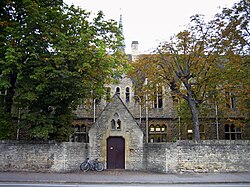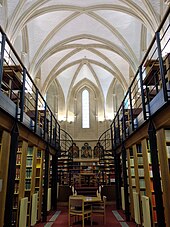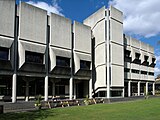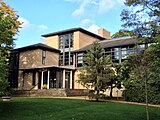Difference between revisions of "St Antony's College, Oxford"
(Created page with "{{Infobox college |name=St Antony's College |county=Oxfordshire |university=Oxford |os grid ref=SP50970742 |latitude=51.763149 |longitude=-1.262903 |city=Oxford |picture=St An...") |
(No difference)
|
Latest revision as of 20:05, 18 March 2024
| St Antony's College Latin: Collegium Sancti Antonii
| |||||||||||||||||||
|
Plus est en vous | |||||||||||||||||||
|---|---|---|---|---|---|---|---|---|---|---|---|---|---|---|---|---|---|---|---|
 Entrance to the old building at St Antony's College | |||||||||||||||||||
| Warden: | Roger Goodman | ||||||||||||||||||
| |||||||||||||||||||
| Location | |||||||||||||||||||
| Grid reference: | SP50970742 | ||||||||||||||||||
| Location: | 51°45’47"N, 1°15’46"W | ||||||||||||||||||
St Antony's College is a constituent college of the University of Oxford. Founded in 1950 as the result of the gift of French merchant Sir Antonin Besse of Aden, St Antony's specialises in international relations, economics, politics, and area studies relative to Europe, Russia, former Soviet states, Latin America, the Middle East, Africa, Japan, China, and South and South East Asia.[1]
The college is located in the north of Oxford, with Woodstock Road to the west, Bevington Road to the south and Winchester Road to the east. St Antony's had a financial endowment of £55.1m as of 2021.[2] Formerly a men's college, it has been coeducational since 1962.[3]
Contents
History
St Antony's was founded in 1950 as the result of the gift of Sir Antonin Besse of Aden, a merchant of French descent.
In 1947, Besse was considering giving around £2 million to the University of Oxford to found a new college. Ultimately, on the advice of his solicitor, R Clyde, who had attended New College, Besse decided to go ahead with the plan and permitted Clyde to approach the university with the offer. The university was initially unreceptive to the offer, and recommended that Besse instead devote his funds to improving the finances of some of the poorer existing colleges. Eventually Besse acquiesced, contributing a total of £250,000 in varied amounts to the following colleges: Keble, Worcester, St Peter's, Wadham, Exeter, Pembroke, Lincoln and St Edmund Hall. After this large contribution, the university decided to reconsider Besse's offer to help found a new college and, recognising the need to provide for the growing number of postgraduate students coming to Oxford, gave the venture their blessing; and in 1948, Besse signed a deed of trust appointing the college's first trustees.
The attention of the university then turned to providing the new college, by then called St Antony's, with a permanent home. Ripon Hall was initially considered as a good option for a building in which to house the college, but its owners refused to sell, forcing the university to continue its search for premises. They looked at several properties in quick succession, including Youlbury, the Wytham Abbey estate, and Manchester College, which was known to be in financial difficulties and which might thus consider the sale of its 19th-century Mansfield Road buildings. None of these options proved tenable, and the college began to look elsewhere. It is said that Besse became very frustrated with the university and its apparent lack of interest in his project at this point, and almost gave up any hope of its completion. However the college finally acquired its current premises at 62 Woodstock Road in 1950.
The College first admitted students in Michaelmas Term 1950 and received its Royal Charter in 1953. A supplementary charter was granted in 1962 to allow the college to admit women as well as men, and in 1963 the College became a full member of the University of Oxford.[3] By 1952 the number of students at St Antony's had increased to 27 and by the end of the decade that number had risen to 260, amongst whom 34 different nationalities were represented. The college initially struggled due to a lack of funding, and in the late 1960s serious consideration was given to uniting St Antony's with All Souls College when All Souls announced its intention to take a more active role in the education of graduate students. The plan did not come to fruition; All Souls rejected the proposed federal nature of the combined institution, saying they would consider nothing less than a full merger, a proposal which St Antony's governing body did not support. St Antony's lack of funds was partly solved under the wardenship of William Deakin, who devoted himself to college fund-raising and secured a number of generous loans from the Ford and Volkswagen foundations. Since then, St Antony's has almost constantly been financially insecure. This led to the cancellation of a number of proposed physical developments at its site on Woodstock Road. Not until the 1990s was it feasible for the college to embark upon a new building programme; however, since then St Antony's has continued to expand and open new specialist centres for the pursuit of area studies. The college is now recognised as one of the world's foremost centres for such studies.[1] and houses centres for the study of Africa, Asia, Europe, Japan, Latin America, the Middle East and Russia and Eurasia.
From the beginning Besse had expressed his hope that the new college, which he intended to open to men "irrespective of origin, race or creed", would prove instrumental in improving international cooperation and intercultural understanding. The college soon announced its primary role as such: "to be a centre of advanced study and research in the fields of modern international history, philosophy, economics and politics and to provide an international centre within the University where graduate students from all over the world can live and work together in close contact with senior members of the University who are specialists in their fields". The college is still true to its founding principle, remaining one of the most international colleges of the university, and home to many of Oxford's region-specific study departments. This latter feature, combined with the wardenship of William Deakin and St Antony's reputation as a key centre for the study of Soviet affairs during the Cold War, led to rumours of links between the college and the British intelligence services; the author Leslie Woodhead wrote to this effect, describing the college as "a fitting gathering place for old spooks".[4] St Antony's became notorious in both the British and Russian press as a "spy college."[5] The character of Roy Bland from John le Carré's Tinker Tailor Soldier Spy is said to have been a top specialist in Soviet satellite states educated at St Antony's, from where he was recruited by George Smiley.
The college's name alludes to its founder, whose name, Antonin Besse, is derived from the same linguistic root. For a long time it was not made clear whether Anthony the Great or Anthony of Padua was the intended namesake. The matter was finally settled in 1961, when the college finally deemed Anthony the Great to be more the appropriate choice, due to his links to one of the college's prime areas of specialisation - the Middle and Near East. Despite this, the college's banner is flown each year on both saints' days as a matter of tradition, and a statue of the "wrong" Anthony, Anthony of Padua (distinguished iconographically by his holding of the Christ-child), stands in the college's Hilda Besse Building.
Buildings and grounds
Main building
The college's main building was built in the early Victorian era for the Society of the Holy and Undivided Trinity at the behest of Marian Rebecca Hughes, the first woman to take monastic vows within the Church of England since the reformation. The order commissioned Charles Buckeridge, a local architect of some renown, to design the convent buildings. After initially proposing a circular design based on the symbolism of the holy trinity, Buckeridge took to a more traditional approach and drew up the plans for what is now St Antony's main building some time before 1865. Whilst initially there were plans to enlarge the convent with a northerly extension, for which place was made in the building's design, further building never took place. The convent finally opened in November 1868.
The total cost of the initial build was eight thousand pounds, a considerable sum at that time. It is said that upon first seeing the convent's new premises, the architect William Butterfield commented that it was the 'best modern building in Oxford after my college', by which he meant Keble. St Antony's acquired the former convent in 1950 after it had been vacated by the convent and Halifax House, which had occupied the premises in the immediate post war period. The building's chapel, which was never consecrated and now houses the college library, was built in the years 1891–1894 to Buckeridge's original design. The three panel paintings round the apse of the former chapel are by Charles Edgar Buckeridge.[6] The main building's undercroft, now the Gulbenkian Reading Room, was initially used by the nuns as a refectory, a role it continued to play until the completion of the Hilda Besse building in 1970.
1960s: The Hilda Besse Building
After a number of ambitious schemes, one of which had been designed by Oscar Niemeyer, to enlarge the college in the 1960s fell through due to lack of funds, the college decided to concentrate its efforts in providing for the construction of a small extension and acquisition of neighbouring properties. The Hilda Besse Building (then known as New Building) was opened in 1970; this building still serves its original purpose in housing the college's dining hall, graduate common room, and buttery (college bar), as well as ancillary meeting rooms. The next major expansion of the college came in 1993 with the completion of a new building to house the Nissan Institute for Japanese Studies and the Bodleian Japanese Library, whilst additional accommodation was not supplied until the Founder's Building was opened to mark the millennium in the year 2000. The Wahba Dining Hall, the main dining hall for the college located on the first floor of the Hilda Besse Building, was also used as a filming location for The Amateur, a 2024 spy film.
2000s: The Gateway Buildings
In the early 21st century not much development took place until completion of the college's new Gateway Buildings in 2013, which provide a new main entrance to the college and form the east, and final, side of the college's first quadrangle.[7] The funding for this was gained in part by Foulath Hadid who, for his outstanding services to the college, was elected to an Honorary Fellowship in 2004, and the Hadid Room, the college's meeting room, was named in his honour.[8]
Libraries and publications
The Old Main Building - the former Holy Trinity Convent which was built in the 1860s - houses the College Library (including the Gulbenkian Reading Room) and the Russian and Eurasian Studies Centre Library. The College Library keeps general collections in modern history, politics, international relations and economics, collections on Europe, Asia, and the non-Slavonic collections on Russia and the former Soviet Union. It holds over 50,000 volumes and back issues of over 300 journal titles. It also houses some 20th-century archive collections, including the Wheeler-Bennett papers. St Antony's is associated with the Oxford Libraries Information System (OLIS), and has been a contributor to the university's online union library catalogue since 1990.
The other libraries on the College site are the Middle East Centre Library, the Bodleian Latin American Centre Library, the Bodleian Japanese Library and the Russian and Eurasian Studies Centre Library, the last of which was refurbished in 2008–2009 as part of the college's rolling construction and rejuvenation program. The college also holds an extensive collection of archival material relating to the Middle East at the Middle East Centre Archive,[9] the premises of which were greatly expanded with the completion of Zaha Hadid's Softbridge building in mid-2014. The area studies libraries on site are unique within the university and thus generally open to all its students, regardless of college affiliation; they typically hold a wide collection of primary language sources and further Anglophone texts - an abundance of specialist material and unique expertise which prompted Leslie Woodhead to comment as follows:[4]
| “ | Generations of well-informed men with unusual backgrounds have passed through the college, excavating the remarkable library and sharing their knowledge of some of the world's more secretive places. |
” |
The college's Graduate Common Room has, since 2005, published a biannual academic journal entitled the St Antony's International Review, which is more commonly known by its acronym - STAIR. The journal represents a medium through which aspiring young academics can publish their work alongside their established policy-makers and their peers. Furthermore, the college publishes a termly newsletter, the Antonian, and a college record - an annual report on college affairs.
Pictures
| ("Wikimedia Commons" has material about St Antony's College, Oxford) |
|
Outside links
References
- ↑ 1.0 1.1 Nicholls, C. (2000). The History of St Antony's College, Oxford, 1950–2000. Palgrave Macmillan UK. pp. 1–31. ISBN 978-0-230-59883-6. https://books.google.com/books?id=0U2BDAAAQBAJ.
- ↑ "St Antony's College : Annual Report and Financial Statements : Year ended 31 July 2021". p. 23. http://d307gmaoxpdmsg.cloudfront.net/collegeaccounts2021/St_Antonys.pdf.
- ↑ 3.0 3.1 "History of St Antony's College" (in en). 3 December 2014. https://www.sant.ox.ac.uk/about-st-antonys/history.
- ↑ 4.0 4.1 Woodhead, Leslie (2005). My Life as a Spy. Macmillan. ISBN 978-1-4050-4086-0. https://books.google.com/books?id=5VuSHQAACAAJ.
- ↑ Fitzpatrick, Sheila (18 May 2014). "Back in the USSR: my life as a 'spy' in the archives". The Conversation. https://theconversation.com/back-in-the-ussr-my-life-as-a-spy-in-the-archives-26303. Retrieved 28 June 2022.
- ↑ Saint, Andrew (1973). "Charles Buckeridge and his family". Oxoniensia 38: 357–372. http://oxoniensia.org/volumes/1973/saint.pdf.
- ↑ "The Gateway Campaign". https://www.sant.ox.ac.uk/alumni-and-development/support-st-antonys/gateway-campaign.
- ↑ Obituary - 'Foulath Hadid: Writer and expert on Arab affairs' - The Independent 11 October 2012
- ↑ "MEC Archive | St Antony's College". 8 December 2014. https://www.sant.ox.ac.uk/research-centres/middle-east-centre/mec-archive.
| Colleges of the University of Oxford | |
|---|---|
| Colleges:
All Souls • Balliol • Brasenose • Christ Church • Corpus Christi • Exeter • Green Templeton • Harris Manchester • Hertford • Jesus • Keble • Kellogg • Lady Margaret Hall • Linacre • Lincoln • Magdalen • Mansfield • Merton • New College • Nuffield • Oriel • Pembroke • The Queen's • Reuben • St Anne's • St Antony's • St Catherine's • St Cross • St Edmund Hall • St Hilda's • St Hugh's • St John's • St Peter's • Somerville • Trinity • University • Wadham • Wolfson • Worcester |
|
| Permanent private halls:
Blackfriars • Campion Hall • Regent's Park College • St Benet's Hall • St Stephen's House • Wycliffe Hall | |











